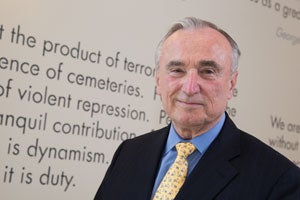William Bratton, former Los Angeles police chief and police commissioner of New York, discussed his new book, “Collaborate or Perish! Reaching across Boundaries in a Networked World” (New York: Crown Business, 2012), at the 13th annual Police Union Leadership Seminar hosted by the Labor & Worklife Program at Harvard Law School. The seminar brings together labor leadership from the nation’s 50 largest cities and connects them with the latest thinking on public safety and labor organizing.
Co-written with Zachary Tumin of the Harvard Kennedy School, Bratton’s book provides a guide and case studies of how people and organizations can collaborate to achieve far-reaching breakthroughs. Early in his talk, Bratton observed that during World War II the word “collaborate” had developed an odious reputation, as it was used to describe those seeking to co-operate with Nazi occupation forces. But in recent decades, “collaboration” has been rescued from this sinister historical epoch, and the word is returning to its original meaning of working together to achieve good and worthy goals.
Illustrated with concrete cases, Bratton outlined eight principles that need to be in place for successful collaboration: 1) “have a vision,” one that “energizes people”; 2) “right-size the way forward,” which means having some small early victories that convince people you can accomplish things; 3) “create a platform” where people can “share knowledge, insight, and assets, and take steps together”; 4) “make it pay” in the sense that collaborators see there is “something in it for everyone – whether it’s glory and honor, money and power, latitude and position, or a chance to do the job they showed up to do”; 5) “have the right people with you”; 6) “deliver on performance,” whether making something “better, faster or cheaper; or more efficient, equitable, or effective”; 7) “mind your political support,” and in particular he criticized politicians who are swift to take credit for declines in crime while showing little support for the rank-and-file officers whose hard-working sweat made it possible; and 8) “have the passion and playbook to lead,” allowing all to “achieve together what none can accomplish alone.”
Bratton discussed several remarkable cases of collaboration such as the network of 19-year-old hacker George Hotz, who almost won the “Network Challenge” of the Defense Advanced Research Projects Agency (DARPA). On December 5, 2009, DARPA set up ten red weather balloons around the USA, and the agency promised $40,000 for the first team to locate them. With nearly 50,000 followers on Twitter, Hotz led the competition for much of the day by rapidly finding eight of the ten balloons. Eventually teams from MIT and Georgia Tech surpassed him, but his third-place finish astonished DARPA. For Bratton, it demonstrated “the raw power of the Internet to foster collaboration” and achieve “far more than what traditional intelligence gathering could accomplish.”
Bratton also provided examples of turnarounds spearheaded by effective collaboration such as the transformation of schools by Rio de Janeiro’s Secretary of Education Claudia Costin and Alcoa CEO Paul O’Neill’s goal of becoming “the safest company in America,” which led to much better relations with the workforce. When an eighteen-year-old worker perished on the job in Arizona, O’Neill told his management team in shockingly blunt terms: “We killed him. But it’s my failure of leadership, and all of you in this chain that caused this young man to be killed.”
Bratton received praise from several police labor leaders who thanked him for working with unions to solve problems, rather than following the path of many other police chiefs who openly boast of having acrimonious relations with worker representatives. Reflecting on Bratton’s approach to collaboration, Dr. Ted Hunt, former President and Secretary of the Los Angeles Police Protective League, concluded the program: “He saved the Los Angeles police department from collapse.”
